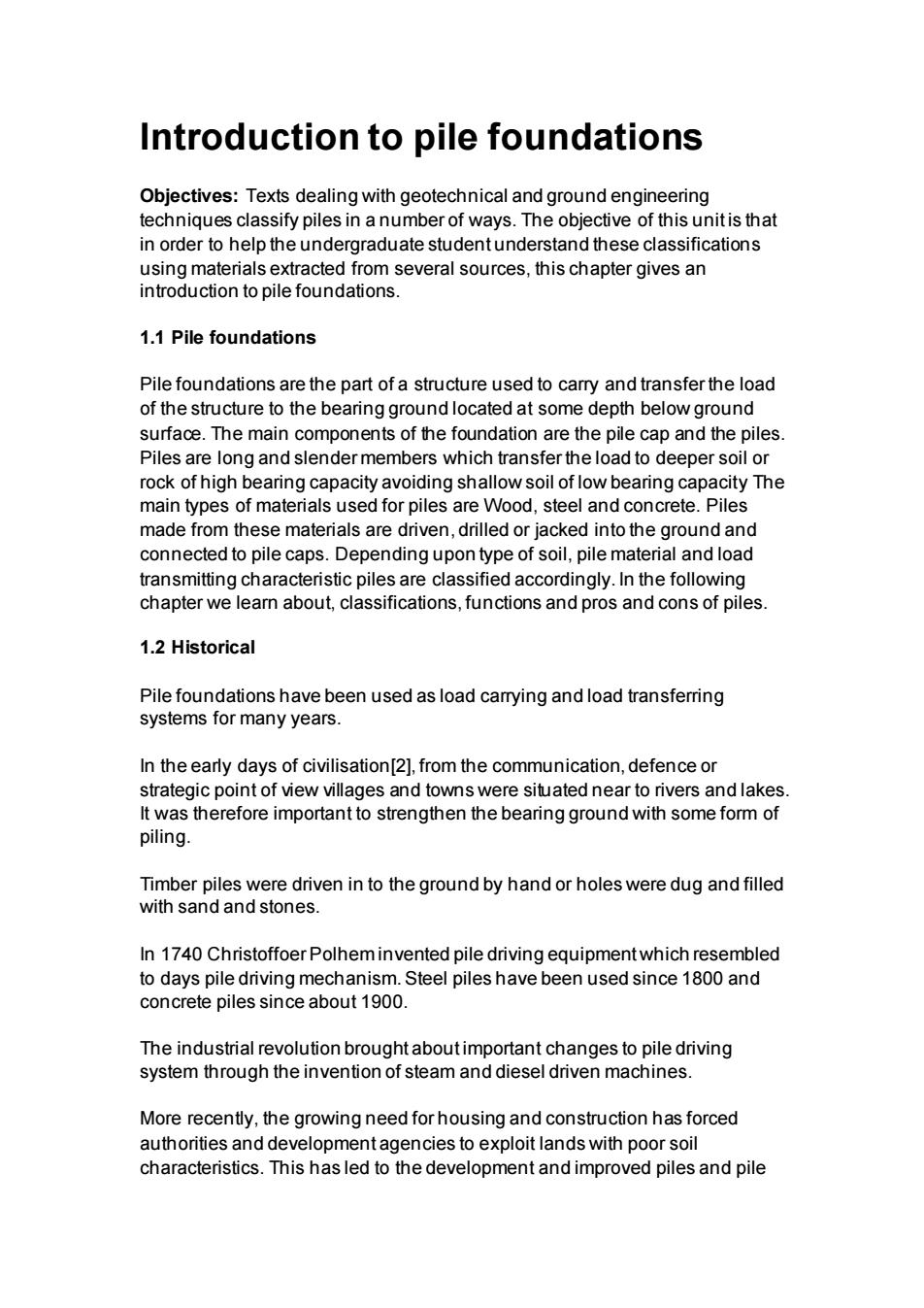
Introduction to pile foundations Objectives:Texts dealing with geotechnical and ground engineering techniques classify piles in a number of ways.The objective of this unit is that in order to help the undergraduate studentunderstand these classifications using materials extracted from several sources this chapter gives an introduction to pile foundations. 1.1 Pile foundations Pile foundations are the part of a structure used to carry and transfer the load of the structure to the bearing ground located at some depth below ground surface.The main components of the foundation are the pile cap and the piles Piles are long and slender members which transfer the load to deeper soil or rock of high bearing capacity avoiding shallow soil of low bearing capacity The made from these materials are driven,drilled or jacked into the ground and connected to pile caps.Depending upon type of soil,pile material and load 1.2 Historical Pile foundations have been used as load camying and load transferring systems for many years. strategic point of view villages and towns were situated near to rivers and lakes It was therefore important to strengthen the bearing ground with some form of piling. were driven in to the ground by hand or holes were dug and filled In 1740 Christoffoer Polhem invented pile driving equipment which resembled to days pile driving mechanism.Steel piles have been used since 1800 and The industrial revolution brought about important changes to pile driving system through the invention of steam and diesel driven machines. More recently,the growing need for housing and construction has forced authorities and development agencies to exploit lands with poor soil characteristics.This has led to the development and improved piles and pile
Introduction to pile foundations Objectives: Texts dealing with geotechnical and ground engineering techniques classify piles in a number of ways. The objective of this unit is that in order to help the undergraduate student understand these classifications using materials extracted from several sources, this chapter gives an introduction to pile foundations. 1.1 Pile foundations Pile foundations are the part of a structure used to carry and transfer the load of the structure to the bearing ground located at some depth below ground surface. The main components of the foundation are the pile cap and the piles. Piles are long and slender members which transfer the load to deeper soil or rock of high bearing capacity avoiding shallow soil of low bearing capacity The main types of materials used for piles are Wood, steel and concrete. Piles made from these materials are driven, drilled or jacked into the ground and connected to pile caps. Depending upon type of soil, pile material and load transmitting characteristic piles are classified accordingly. In the following chapter we learn about, classifications, functions and pros and cons of piles. 1.2 Historical Pile foundations have been used as load carrying and load transferring systems for many years. In the early days of civilisation[2], from the communication, defence or strategic point of view villages and towns were situated near to rivers and lakes. It was therefore important to strengthen the bearing ground with some form of piling. Timber piles were driven in to the ground by hand or holes were dug and filled with sand and stones. In 1740 Christoffoer Polhem invented pile driving equipment which resembled to days pile driving mechanism. Steel piles have been used since 1800 and concrete piles since about 1900. The industrial revolution brought about important changes to pile driving system through the invention of steam and diesel driven machines. More recently, the growing need for housing and construction has forced authorities and development agencies to exploit lands with poor soil characteristics. This has led to the development and improved piles and pile
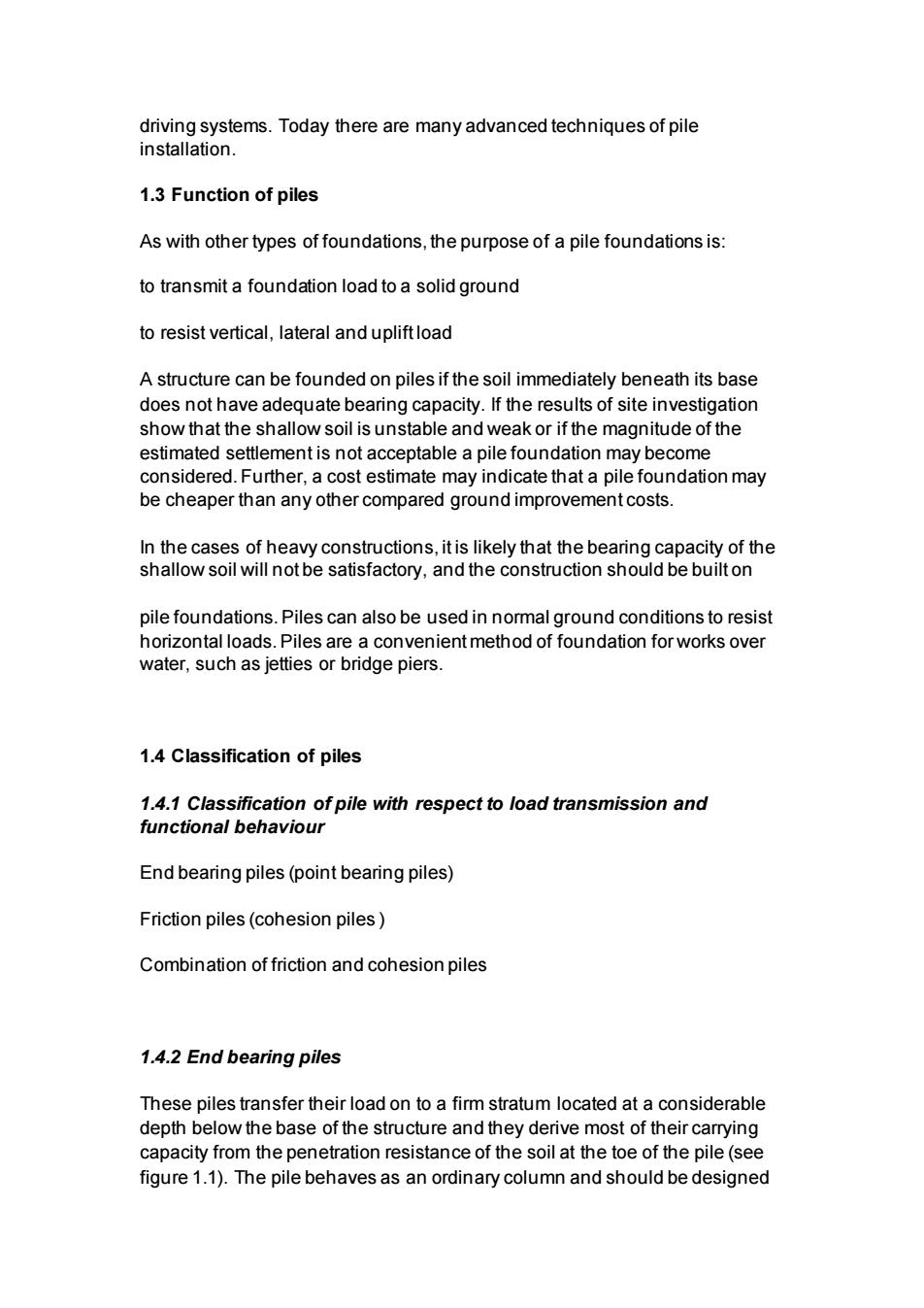
driving systems.Today there are many advanced techniques of pile installation. 1.3 Function of piles As with other types of foundations,the purpose of a pile foundations is: to transmit a foundation load to a solid ground to resist vertical,lateral and uplift load A structure can be founded on piles if the soil immediately beneath its base does nothave adequate bearing capacity.If site investigation show that the shallow soil is unstable and weak or if the magnitude of the estimated settlement is not acceptable a pile foundation may become considered.Further,a cost estimate may indicate that a pile foundation may be cheaper than any other compared ground improvement costs. In the cases of heavy constructions.it is likely that the bearing capacity of the shallow soil will not be satisfactory.and the construction should be built on pile foundations.Piles can also be used in r norma Iground conditions to resist horizontal loads.Piles are a convenient method of foundation for works over water,such as jetties or bridge piers. 1.4 Classification of piles 1.4.1 Classification of pile with respect to load transmission and functional behaviour End bearing piles(point bearing piles) Friction piles(cohesion piles) Combination of friction and cohesion piles 1.4.2 End bearing piles These piles transfer their load on to a firm stratum located at a considerable depth be ow the base of the structure and they derive most of their carrying capacity from the penetration resistance of the soil at the toe of the pile(see figure 1.1).The pile behaves as an ordinary column and should be designed
driving systems. Today there are many advanced techniques of pile installation. 1.3 Function of piles As with other types of foundations, the purpose of a pile foundations is: to transmit a foundation load to a solid ground to resist vertical, lateral and uplift load A structure can be founded on piles if the soil immediately beneath its base does not have adequate bearing capacity. If the results of site investigation show that the shallow soil is unstable and weak or if the magnitude of the estimated settlement is not acceptable a pile foundation may become considered. Further, a cost estimate may indicate that a pile foundation may be cheaper than any other compared ground improvement costs. In the cases of heavy constructions, it is likely that the bearing capacity of the shallow soil will not be satisfactory, and the construction should be built on pile foundations. Piles can also be used in normal ground conditions to resist horizontal loads. Piles are a convenient method of foundation for works over water, such as jetties or bridge piers. 1.4 Classification of piles 1.4.1 Classification of pile with respect to load transmission and functional behaviour End bearing piles (point bearing piles) Friction piles (cohesion piles ) Combination of friction and cohesion piles 1.4.2 End bearing piles These piles transfer their load on to a firm stratum located at a considerable depth below the base of the structure and they derive most of their carrying capacity from the penetration resistance of the soil at the toe of the pile (see figure 1.1). The pile behaves as an ordinary column and should be designed
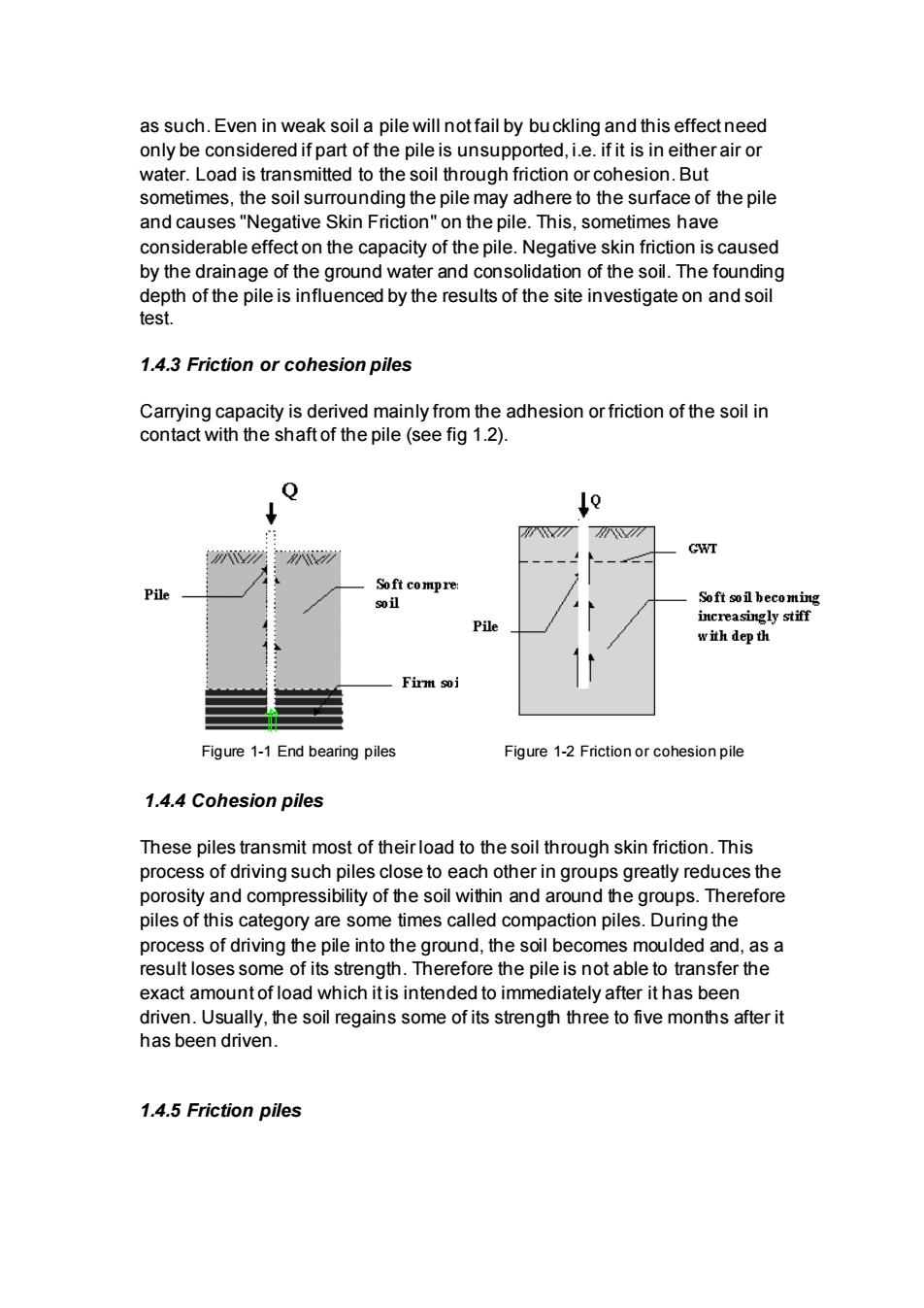
as such.Even in weak soil a pile will not fail by bu ckling and this effect need only be considered if part of the pile is water.Load is transmitted to the soil through friction or cohesion.But sometimes,the soil surrounding the pile may adhere to the surface of the pile and causes"Negative Skin Friction"on the pile.This,sometimes have considerable effect on the capacity of the pile.Negative skin friction is caused by the dra nag eof the grounc ater and f the soil.The fou peis inuenced by the results of the site investigate on 1.4.3 Friction or cohesion piles Carrying capacity is derived mainly from the adhesion or friction of the soil in contact with the shaft of the pile(see fig 1.2). Soft soil be th dep th Firm soi Figure1-1 End bearing piles Figure 1-2 Frictionor cohesion pile 1.4.4 Cohesion piles These piles transmit most of theirload to the soil through skin friction.This process of driving such piles close to each other in groups greatly reduces the porosity and compressibility of the soil within and around the groups.Therefore piles of this category are some times called compaction piles.During the process of driving the pile into the ground,the soil becomes moulded and,as a result loses some of its strength.Therefore the pile is not able to transfer the exact amount 01 oad which itis intended to immediately after it has b driven.Usually,the soil regains some of its strength three to five months after it has been driven. 1.4.5 Friction piles
as such. Even in weak soil a pile will not fail by buckling and this effect need only be considered if part of the pile is unsupported, i.e. if it is in either air or water. Load is transmitted to the soil through friction or cohesion. But sometimes, the soil surrounding the pile may adhere to the surface of the pile and causes "Negative Skin Friction" on the pile. This, sometimes have considerable effect on the capacity of the pile. Negative skin friction is caused by the drainage of the ground water and consolidation of the soil. The founding depth of the pile is influenced by the results of the site investigate on and soil test. 1.4.3 Friction or cohesion piles Carrying capacity is derived mainly from the adhesion or friction of the soil in contact with the shaft of the pile (see fig 1.2). Figure 1-1 End bearing piles Figure 1-2 Friction or cohesion pile 1.4.4 Cohesion piles These piles transmit most of their load to the soil through skin friction. This process of driving such piles close to each other in groups greatly reduces the porosity and compressibility of the soil within and around the groups. Therefore piles of this category are some times called compaction piles. During the process of driving the pile into the ground, the soil becomes moulded and, as a result loses some of its strength. Therefore the pile is not able to transfer the exact amount of load which it is intended to immediately after it has been driven. Usually, the soil regains some of its strength three to five months after it has been driven. 1.4.5 Friction piles
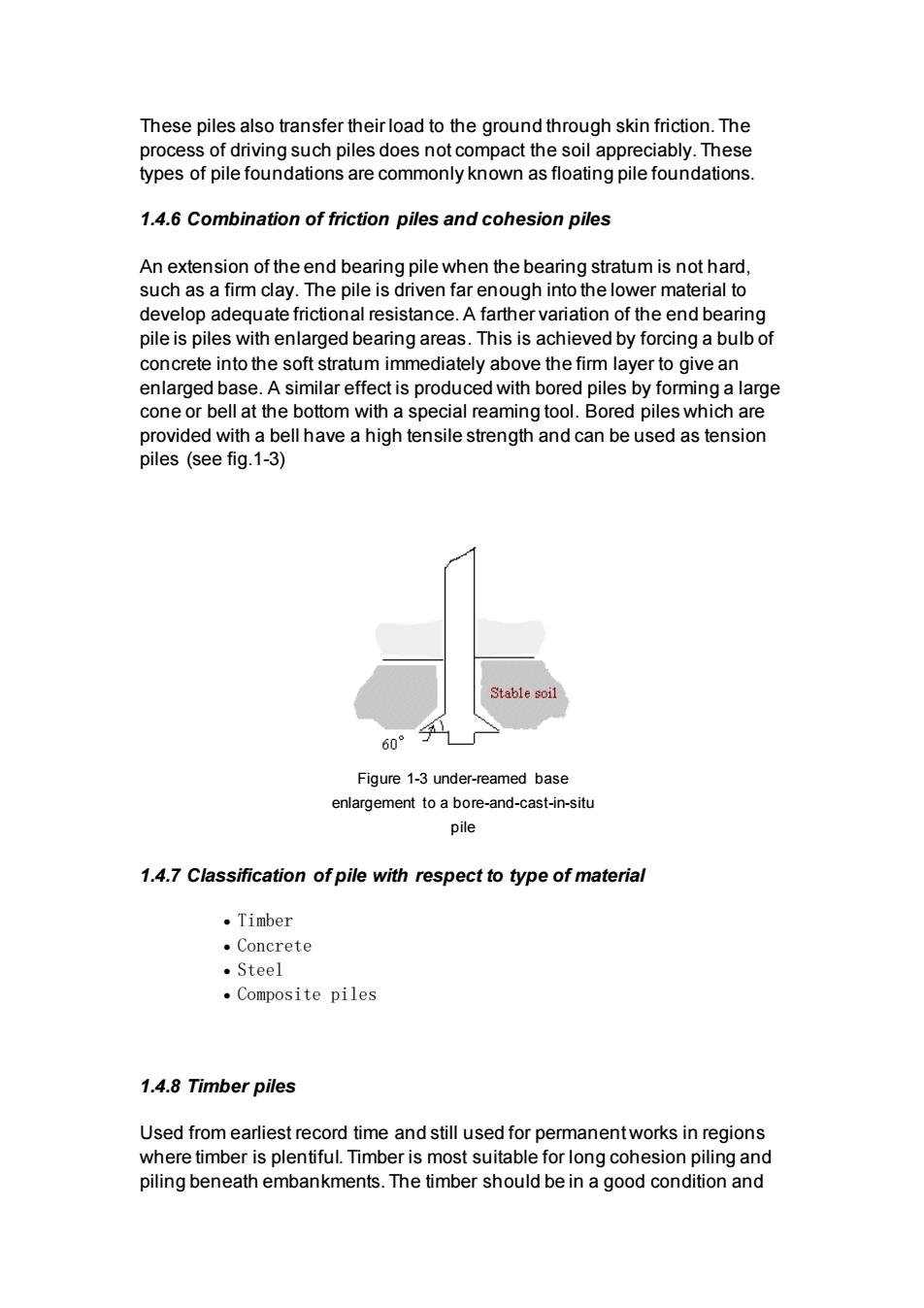
These piles also transfer theirload to the around through skin friction.the of driv such piles does not c ompact the soi app types of pile foun ndations 1.4.6 Combination of friction piles and cohesion piles An extension of the end bearing pile when the bearing stratum is not hard, such as a firm clay.The pile is driven far enough into the lower material to develop adequate frictional resistance.a farther variation of the end bearing pile is piles eas.This is achieved by forcing a bulb of concrete into the soft stratum immediately above the firm layer to give an enlarged base.A similar effect is produced with bored piles by forming a large cone or bell at the bottom with a special reaming tool.Bored piles which are provided with a bell have a high tensile strength and can be used as tension piles (see fig.1-3) able so 60° Figure 1-3 under-reamed base enlargement to a bore-and-cast-in-situ pile 1.4.7 Classification of pile with respect to type of material 。Timber Concrete 。Steel Composite piles 1.4.8 Timber piles Used from earliest record time and still used for permanent works in regions where timber is plentiful.Timber is most suitable for long cohesion piling and piling beneath embankments.The timber should be in a good condition and
These piles also transfer their load to the ground through skin friction. The process of driving such piles does not compact the soil appreciably. These types of pile foundations are commonly known as floating pile foundations. 1.4.6 Combination of friction piles and cohesion piles An extension of the end bearing pile when the bearing stratum is not hard, such as a firm clay. The pile is driven far enough into the lower material to develop adequate frictional resistance. A farther variation of the end bearing pile is piles with enlarged bearing areas. This is achieved by forcing a bulb of concrete into the soft stratum immediately above the firm layer to give an enlarged base. A similar effect is produced with bored piles by forming a large cone or bell at the bottom with a special reaming tool. Bored piles which are provided with a bell have a high tensile strength and can be used as tension piles (see fig.1-3) Figure 1-3 under-reamed base enlargement to a bore-and-cast-in-situ pile 1.4.7 Classification of pile with respect to type of material • Timber • Concrete • Steel • Composite piles 1.4.8 Timber piles Used from earliest record time and still used for permanent works in regions where timber is plentiful. Timber is most suitable for long cohesion piling and piling beneath embankments. The timber should be in a good condition and
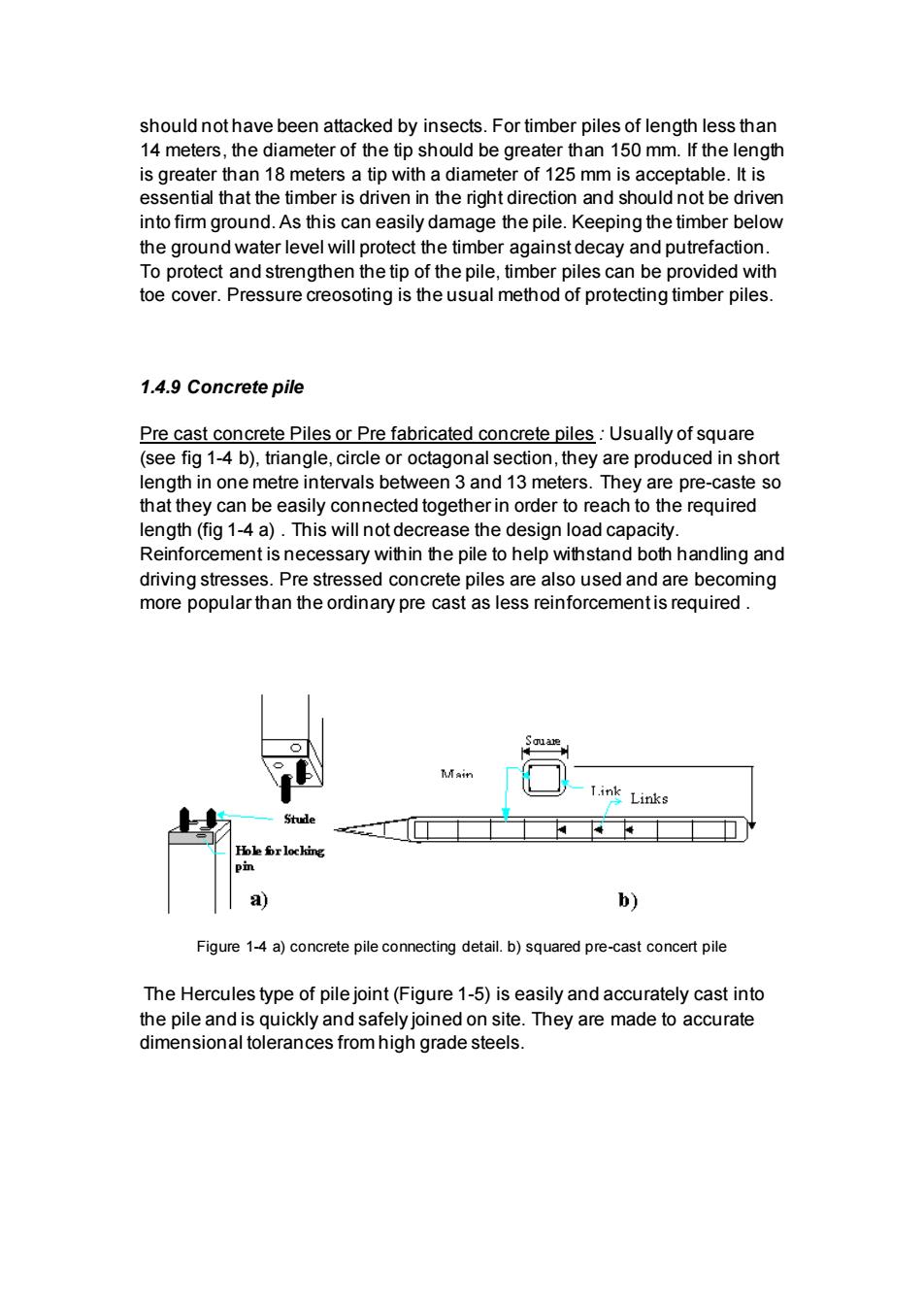
should not have been attacked by insects.For timber piles of length less than 14 meters the diameter of the tip should be grea than 150 mm if the is greater than 18 meters a tip with a diameter of 125 mm is acceptable.It is essential that the timber is driven in the right direction and should not be driven into firm ground.As this can easily damage the pile.Keeping the timber below the ground water level will protect the timber against decay and putrefaction. Toprotect rengthen the tip of the pile.tim r piles be prov ided toe cover.Pressure creosoting is theusual method of protecting timber piles 1.4.9 Concrete pile Pre cast concrete Piles or Pre fabricated concrete piles:Usually of square (see fig 1-4 b),triangle,circle or octagonal section,they are produced in short one m They are pre so sily conne length(fig 1-4 a).This will not decrease the design load capacity. Reinforcement is necessary within the pile to help withstand both handling and drivina stresses.pre stressed concrete piles are also used and are becomina more popular than the ordinary pre cast as less reinforcementis required. Links a) Figure 1-a)concrete pile connecting detail.b)squared pre-cast concert pile The Hercules type of pile joint(Figure 1-5)is easily and accurately cast into the pile and is quickly and safely joined on site.They are made to accurate dimensional tolerances from high grade steels
should not have been attacked by insects. For timber piles of length less than 14 meters, the diameter of the tip should be greater than 150 mm. If the length is greater than 18 meters a tip with a diameter of 125 mm is acceptable. It is essential that the timber is driven in the right direction and should not be driven into firm ground. As this can easily damage the pile. Keeping the timber below the ground water level will protect the timber against decay and putrefaction. To protect and strengthen the tip of the pile, timber piles can be provided with toe cover. Pressure creosoting is the usual method of protecting timber piles. 1.4.9 Concrete pile Pre cast concrete Piles or Pre fabricated concrete piles : Usually of square (see fig 1-4 b), triangle, circle or octagonal section, they are produced in short length in one metre intervals between 3 and 13 meters. They are pre-caste so that they can be easily connected together in order to reach to the required length (fig 1-4 a) . This will not decrease the design load capacity. Reinforcement is necessary within the pile to help withstand both handling and driving stresses. Pre stressed concrete piles are also used and are becoming more popular than the ordinary pre cast as less reinforcement is required . Figure 1-4 a) concrete pile connecting detail. b) squared pre-cast concert pile The Hercules type of pile joint (Figure 1-5) is easily and accurately cast into the pile and is quickly and safely joined on site. They are made to accurate dimensional tolerances from high grade steels